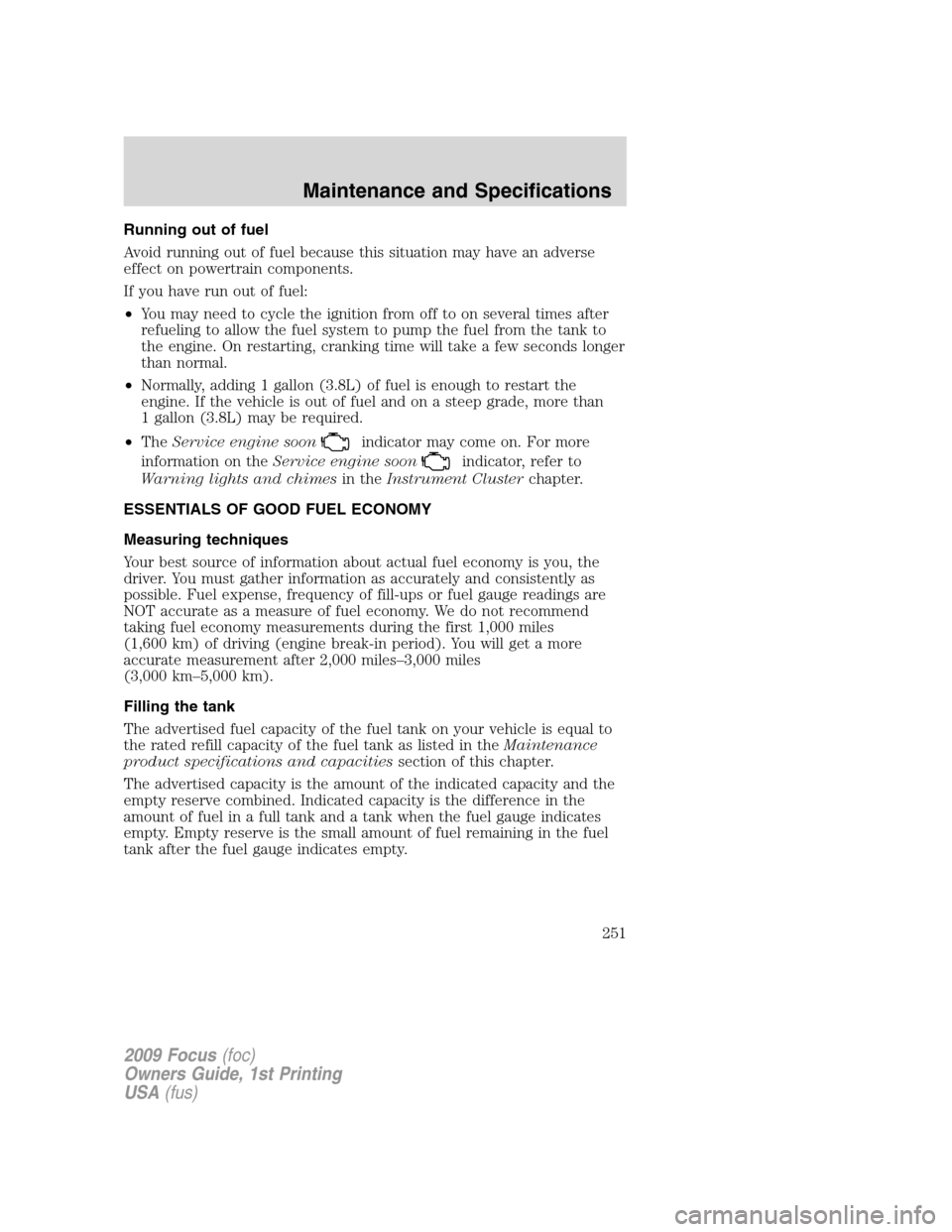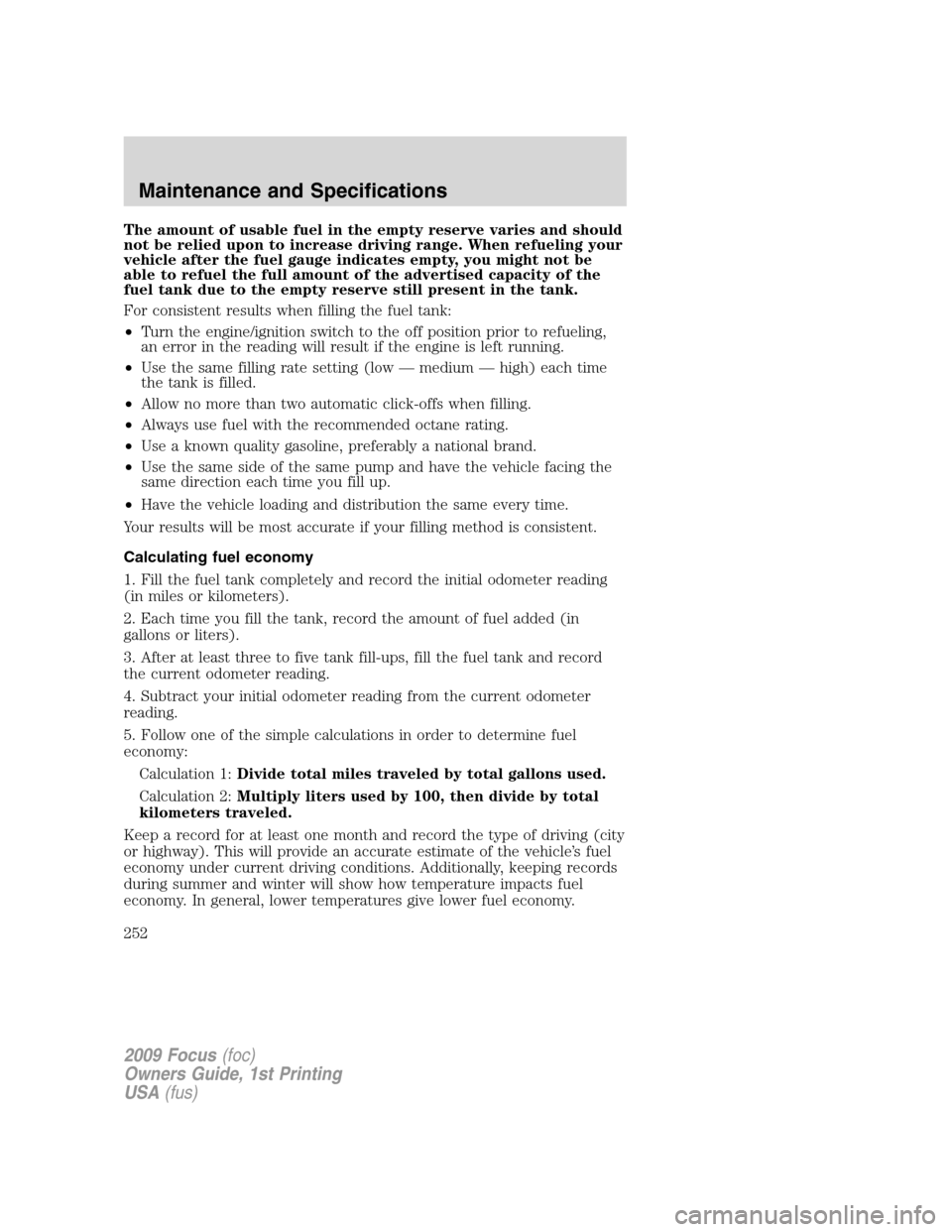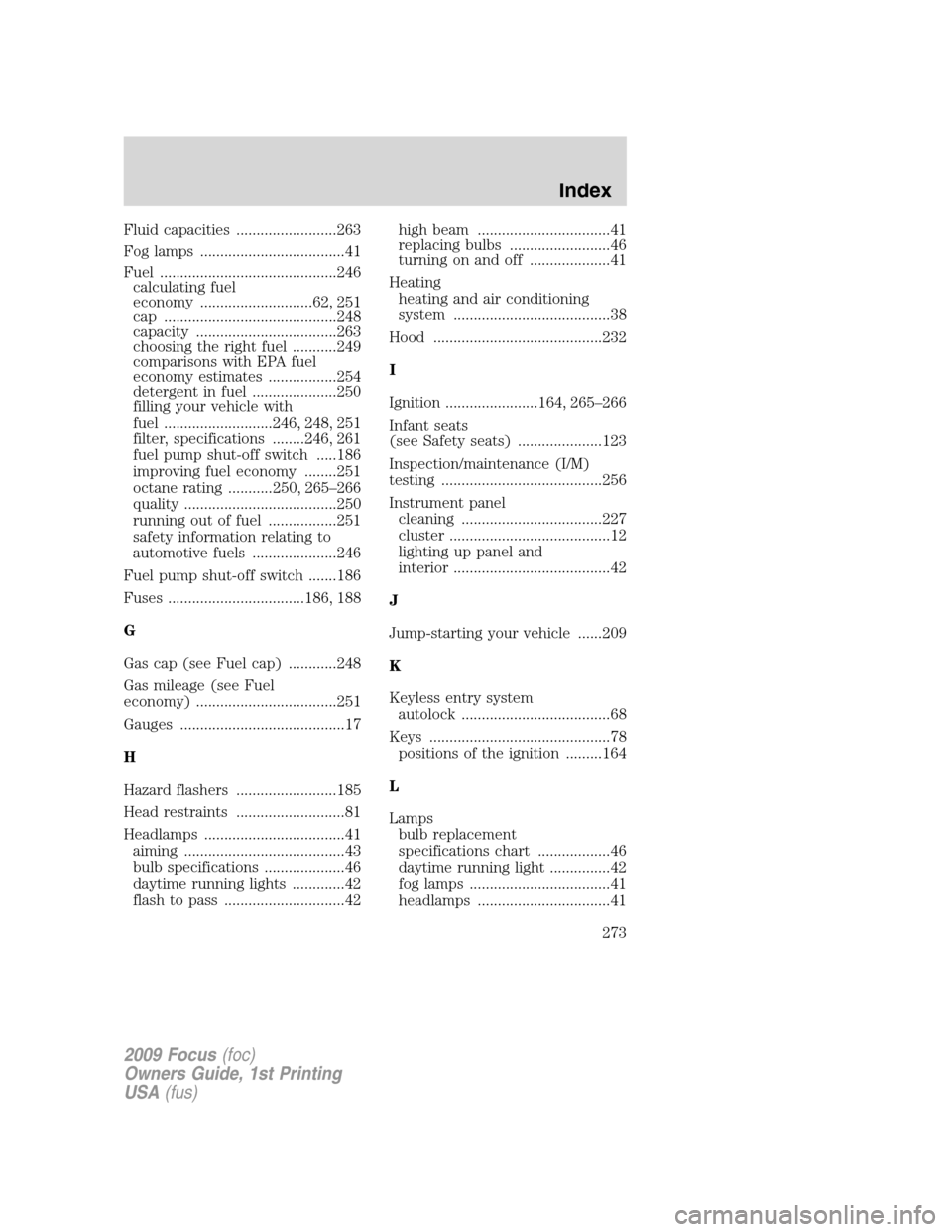2009 FORD FOCUS ignition
[x] Cancel search: ignitionPage 192 of 276

Fuse/Relay
LocationFuse Amp
RatingProtected circuits
19 — Not used
20 — A/C clutch relay
21A Rear defrost relay
21B — Not used
21C — Blower relay
21D — PCM relay
22 10A Fuel injector
23 — Not used
24 — Not used
25 — Not used
26 15A PCM MIL
27 — Not used
28 15A PCM
29 15A Ignition
30A — Cooling fan low speed relay
30B — Starter relay
30C — Not used
30D — Cooling fan high speed relay
31A — Reverse lamp relay
31B — Fuel pump relay
31C — Wiper power relay
31D — Not used
31E — Not used
31F — Not used
32 — A/C clutch diode
33 — EEC diode
34 — One Touch Integrated Start
(OTIS) diode
35 10A Run/Start
2009 Focus(foc)
Owners Guide, 1st Printing
USA(fus)
Roadside Emergencies
192
Page 251 of 276

Running out of fuel
Avoid running out of fuel because this situation may have an adverse
effect on powertrain components.
If you have run out of fuel:
•You may need to cycle the ignition from off to on several times after
refueling to allow the fuel system to pump the fuel from the tank to
the engine. On restarting, cranking time will take a few seconds longer
than normal.
•Normally, adding 1 gallon (3.8L) of fuel is enough to restart the
engine. If the vehicle is out of fuel and on a steep grade, more than
1 gallon (3.8L) may be required.
•TheService engine soon
indicator may come on. For more
information on theService engine soon
indicator, refer to
Warning lights and chimesin theInstrument Clusterchapter.
ESSENTIALS OF GOOD FUEL ECONOMY
Measuring techniques
Your best source of information about actual fuel economy is you, the
driver. You must gather information as accurately and consistently as
possible. Fuel expense, frequency of fill-ups or fuel gauge readings are
NOT accurate as a measure of fuel economy. We do not recommend
taking fuel economy measurements during the first 1,000 miles
(1,600 km) of driving (engine break-in period). You will get a more
accurate measurement after 2,000 miles–3,000 miles
(3,000 km–5,000 km).
Filling the tank
The advertised fuel capacity of the fuel tank on your vehicle is equal to
the rated refill capacity of the fuel tank as listed in theMaintenance
product specifications and capacitiessection of this chapter.
The advertised capacity is the amount of the indicated capacity and the
empty reserve combined. Indicated capacity is the difference in the
amount of fuel in a full tank and a tank when the fuel gauge indicates
empty. Empty reserve is the small amount of fuel remaining in the fuel
tank after the fuel gauge indicates empty.
2009 Focus(foc)
Owners Guide, 1st Printing
USA(fus)
Maintenance and Specifications
251
Page 252 of 276

The amount of usable fuel in the empty reserve varies and should
not be relied upon to increase driving range. When refueling your
vehicle after the fuel gauge indicates empty, you might not be
able to refuel the full amount of the advertised capacity of the
fuel tank due to the empty reserve still present in the tank.
For consistent results when filling the fuel tank:
•Turn the engine/ignition switch to the off position prior to refueling,
an error in the reading will result if the engine is left running.
•Use the same filling rate setting (low — medium — high) each time
the tank is filled.
•Allow no more than two automatic click-offs when filling.
•Always use fuel with the recommended octane rating.
•Use a known quality gasoline, preferably a national brand.
•Use the same side of the same pump and have the vehicle facing the
same direction each time you fill up.
•Have the vehicle loading and distribution the same every time.
Your results will be most accurate if your filling method is consistent.
Calculating fuel economy
1. Fill the fuel tank completely and record the initial odometer reading
(in miles or kilometers).
2. Each time you fill the tank, record the amount of fuel added (in
gallons or liters).
3. After at least three to five tank fill-ups, fill the fuel tank and record
the current odometer reading.
4. Subtract your initial odometer reading from the current odometer
reading.
5. Follow one of the simple calculations in order to determine fuel
economy:
Calculation 1:Divide total miles traveled by total gallons used.
Calculation 2:Multiply liters used by 100, then divide by total
kilometers traveled.
Keep a record for at least one month and record the type of driving (city
or highway). This will provide an accurate estimate of the vehicle’s fuel
economy under current driving conditions. Additionally, keeping records
during summer and winter will show how temperature impacts fuel
economy. In general, lower temperatures give lower fuel economy.
2009 Focus(foc)
Owners Guide, 1st Printing
USA(fus)
Maintenance and Specifications
252
Page 254 of 276
![FORD FOCUS 2009 2.G Owners Manual Conditions
•Heavily loading a vehicle or towing a trailer may reduce fuel economy
at any speed.
•Carrying unnecessary weight may reduce fuel economy (approximately
1 mpg [0.4 km/L] is lost for eve FORD FOCUS 2009 2.G Owners Manual Conditions
•Heavily loading a vehicle or towing a trailer may reduce fuel economy
at any speed.
•Carrying unnecessary weight may reduce fuel economy (approximately
1 mpg [0.4 km/L] is lost for eve](/manual-img/11/5135/w960_5135-253.png)
Conditions
•Heavily loading a vehicle or towing a trailer may reduce fuel economy
at any speed.
•Carrying unnecessary weight may reduce fuel economy (approximately
1 mpg [0.4 km/L] is lost for every 400 lb [180 kg] of weight carried).
•Adding certain accessories to your vehicle (for example bug
deflectors, rollbars/light bars, running boards, ski/luggage racks) may
reduce fuel economy.
•Using fuel blended with alcohol may lower fuel economy.
•Fuel economy may decrease with lower temperatures during the first
8–10 miles (12–16 km) of driving.
•Driving on flat terrain offers improved fuel economy as compared to
driving on hilly terrain.
•Transmissions give their best fuel economy when operated in the top
cruise gear and with steady pressure on the gas pedal.
•Close windows for high speed driving.
EPA fuel economy estimates
Every new vehicle should have a window sticker containing EPA fuel
economy estimates. Contact your authorized dealer if the window sticker
is not supplied with your vehicle. The EPA fuel economy estimates
should be your guide for the fuel economy comparisons with other
vehicles. Your fuel economy may vary depending upon the method of
operation and conditions.
EMISSION CONTROL SYSTEM
Your vehicle is equipped with various emission control components and a
catalytic converter which will enable your vehicle to comply with
applicable exhaust emission standards. To make sure that the catalytic
converter and other emission control components continue to work
properly:
•Use only the specified fuel listed.
•Avoid running out of fuel.
•Do not turn off the ignition while your vehicle is moving, especially at
high speeds.
•Have the items listed inscheduled maintenance information
performed according to the specified schedule.
2009 Focus(foc)
Owners Guide, 1st Printing
USA(fus)
Maintenance and Specifications
254
Page 256 of 276

a malfunction. Temporary malfunctions may cause theService engine
soon
indicator to illuminate. Examples are:
1. The vehicle has run out of fuel—the engine may misfire or run poorly.
2. Poor fuel quality or water in the fuel—the engine may misfire or run
poorly.
3. The fuel cap may not have been securely tightened. SeeFuel filler
capin this chapter.
4. Driving through deep water—the electrical system may be wet.
These temporary malfunctions can be corrected by filling the fuel tank
with good quality fuel, properly tightening the fuel cap or letting the
electrical system dry out. After three driving cycles without these or any
other temporary malfunctions present, theService engine soon
indicator should stay off the next time the engine is started. A driving
cycle consists of a cold engine startup followed by mixed city/highway
driving. No additional vehicle service is required.
If theService engine soon
indicator remains on, have your vehicle
serviced at the first available opportunity. Although some malfunctions
detected by the OBD-II may not have symptoms that are apparent,
continued driving with theService engine soon
indicator on can
result in increased emissions, lower fuel economy, reduced engine and
transmission smoothness, and lead to more costly repairs.
Readiness for Inspection/Maintenance (I/M) testing
Some state/provincial and local governments may have
Inspection/Maintenance (I/M) programs to inspect the emission control
equipment on your vehicle. Failure to pass this inspection could prevent
you from getting a vehicle registration. Your vehicle may not pass the I/M
test if theService engine soon
indicator is on or not working
properly (bulb is burned out), or if the OBD-II system has determined
that some of the emission control systems have not been properly
checked. In this case, the vehicle is considered not ready for I/M testing.
If theService engine soon
indicator is on or the bulb does not
work, the vehicle may need to be serviced. Refer to the On board
diagnostics (OBD-II) description in this chapter.
If the vehicle’s engine or transmission has just been serviced, or the
battery has recently run down or been replaced, the OBD-II system may
indicate that the vehicle is not ready for I/M testing. To determine if the
vehicle is ready for I/M testing, turn the ignition key to the on position
2009 Focus(foc)
Owners Guide, 1st Printing
USA(fus)
Maintenance and Specifications
256
Page 265 of 276

ENGINE DATA
Engine 2.0L I4 engine
Cubic inches 121
Required fuel 87 octane
Firing order 1–3–4–2
Ignition system C.O.P
Compression ratio 10.0:1
Spark plug gap .051 inch +/- .002
(1.3 mm +/- .05)
2009 Focus(foc)
Owners Guide, 1st Printing
USA(fus)
Maintenance and Specifications
265
Page 273 of 276

Fluid capacities .........................263
Fog lamps ....................................41
Fuel ............................................246
calculating fuel
economy ............................62, 251
cap ...........................................248
capacity ...................................263
choosing the right fuel ...........249
comparisons with EPA fuel
economy estimates .................254
detergent in fuel .....................250
filling your vehicle with
fuel ...........................246, 248, 251
filter, specifications ........246, 261
fuel pump shut-off switch .....186
improving fuel economy ........251
octane rating ...........250, 265–266
quality ......................................250
running out of fuel .................251
safety information relating to
automotive fuels .....................246
Fuel pump shut-off switch .......186
Fuses ..................................186, 188
G
Gas cap (see Fuel cap) ............248
Gas mileage (see Fuel
economy) ...................................251
Gauges .........................................17
H
Hazard flashers .........................185
Head restraints ...........................81
Headlamps ...................................41
aiming ........................................43
bulb specifications ....................46
daytime running lights .............42
flash to pass ..............................42high beam .................................41
replacing bulbs .........................46
turning on and off ....................41
Heating
heating and air conditioning
system .......................................38
Hood ..........................................232
I
Ignition .......................164, 265–266
Infant seats
(see Safety seats) .....................123
Inspection/maintenance (I/M)
testing ........................................256
Instrument panel
cleaning ...................................227
cluster ........................................12
lighting up panel and
interior .......................................42
J
Jump-starting your vehicle ......209
K
Keyless entry system
autolock .....................................68
Keys .............................................78
positions of the ignition .........164
L
Lamps
bulb replacement
specifications chart ..................46
daytime running light ...............42
fog lamps ...................................41
headlamps .................................41
2009 Focus(foc)
Owners Guide, 1st Printing
USA(fus)
Index
273